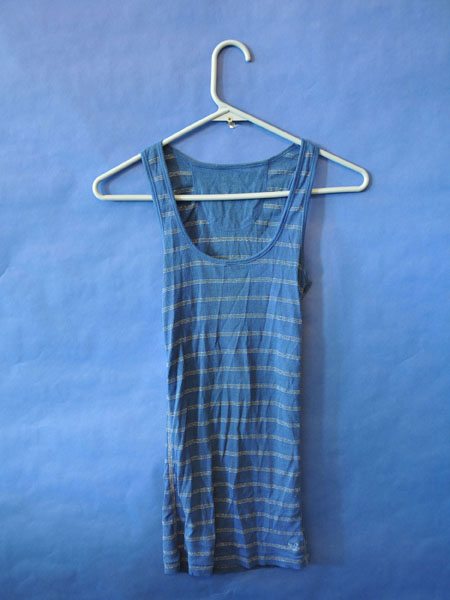![]() body | color | collections | commodity | cube | document | fabric | fetish | gender | glass | home | identity | living | machine | metal | minimal | mobility | narrative | olfactory | organic |
body | color | collections | commodity | cube | document | fabric | fetish | gender | glass | home | identity | living | machine | metal | minimal | mobility | narrative | olfactory | organic |
![]() pain | paper | plastic | plugs | power | protective | rectangular | ritual | round | sound | souvenir | spiritual | style | text-based | time | tool | touch | uniform | value | visual | warm | wood
pain | paper | plastic | plugs | power | protective | rectangular | ritual | round | sound | souvenir | spiritual | style | text-based | time | tool | touch | uniform | value | visual | warm | wood
| Clothing: Blue and Silver Tank Top | |||
Narrative: Blue and silver stripe tank top by American Eagel given to me as a gift from my sister for my birthday in 2008. The cotton process demands cultivators rip out weeds and grass that may compete with the cotton. Land is plowed under and soil is broken up and formed into rows. Cottonseed is planted. The boll matures in a period that ranges from 55 to 80 days. Ten weeks after flowers first appeared, fibers split the boll apart, and cotton pushes forth. The process includes seeding, picking, ginning, and baling. Samples are taken from the bales to determine the quality of the cotton. At this point the cotton plant is defoliated if it is to be machine harvested. Defoliation is often accomplished by spraying the plant with a chemical. At a mill the bale is broken, the fibers are opened by a comb-like device, mixed together, and cleaned. The cleaned cotton fibers are called laps. The laps are fed into a carding machine that separates the fibers. Further cleaning, combing, and sorting readies the fibers for processing into thread. Power generation and supply; Cotton farming; Truck transportation; Oil and gas extraction; Other basic organic chemical manufacturing; Artificial and synthetic fibers and filaments manufacturing; Hosiery and sock mills; Petroleum refineries; Iron and steel mills; Plastics material and resin manufacturing. Water withdraw includes: Cotton farming; Grain farming; Artificial and synthetic fibers and filaments manufacturing; Hosiery and sock mills; Power generation and supply; Fiber, yarn, and thread mills; Other basic organic chemical manufacturing; Paperboard mills; Paint and coating manufacturing; Synthetic dye and pigment manufacturing.
|
 |
||
![]()
